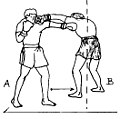This article needs additional citations for verification .(November 2023) |
 Right overhand in medium range | |
| Also known as | |
|---|---|
| Focus | Striking |
An overhand (or overcut or drop) punch is a semi-circular and vertical punch thrown with the lead or rear hand. [1] [2] It is designed to go over the opponent's lead hand or jab to hit their head. [3] The overhand is a versatile counter-punch used to surprise an opponent, land a knockout blow, or as part of a setup for other combinations. It's executed by driving off the back leg, dropping the body and head to the side, and using a looping motion to arc the arm downwards onto the target. [4] The strategic utility of the drop relying on body weight can deliver a great deal of power. [1] [2] It can also be employed when the opponent is bobbing or slipping.
Contents
- Left overhand in long range
- Right overhand in long range
- Left overhand in long range and counterpunch


